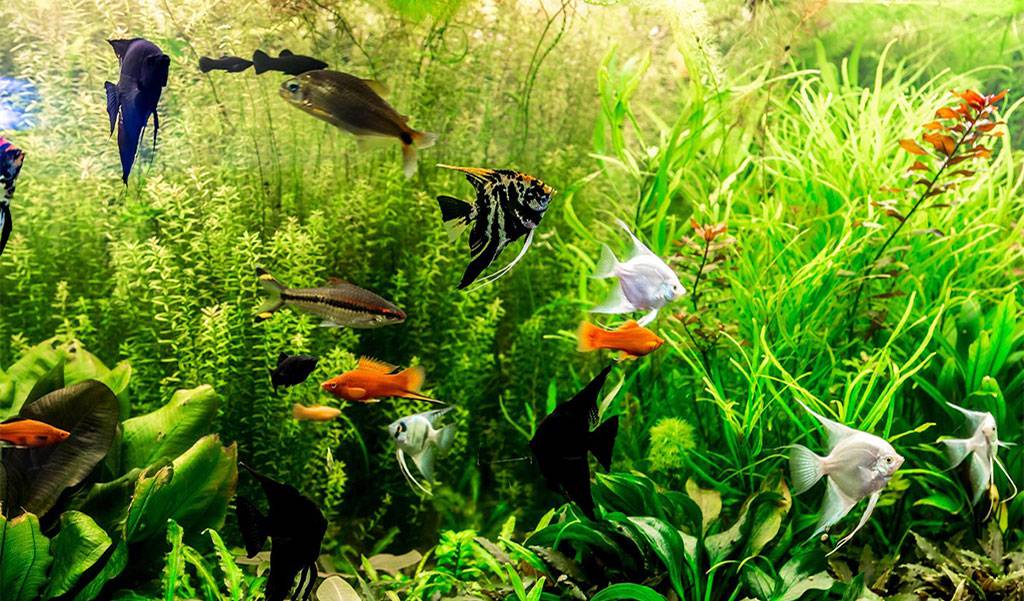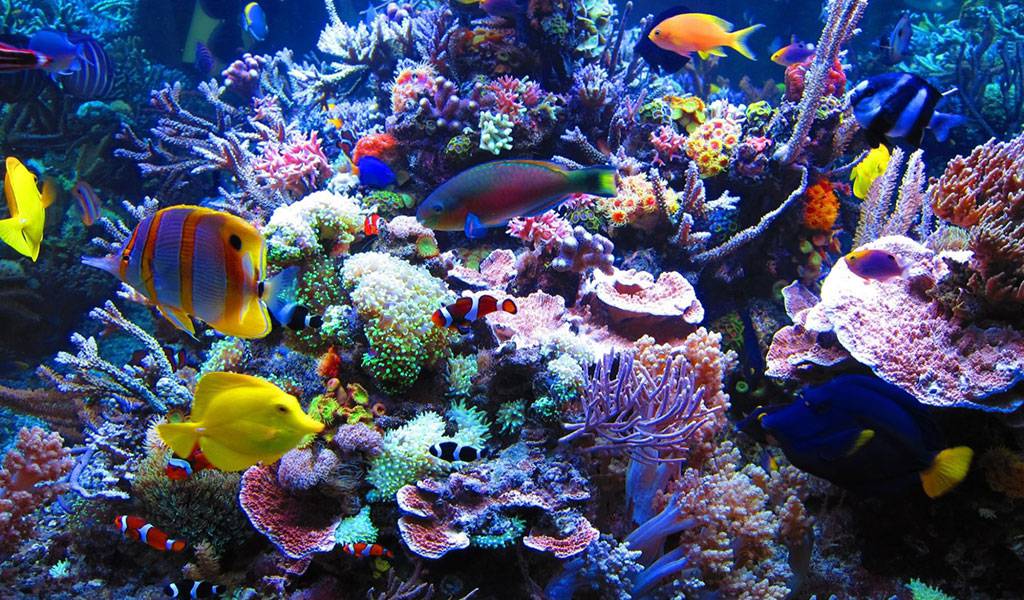Overstock would induce fights between fish, much fish feces and waste, plus the risk of poor water quality, or other damaging issues. So, if you’re ready to dive deeper into the aquatic world of tropical fish and learn more about the tropical fish tank size, then let’s begin.
How size affects the aquarium’s weight
Generally, if you want to buy a new aquarium, you should consider whether your floor, desk or other places can hold your aquarium or not. And the tank length, width, and height determine the tank volume, plus the tank weight. Consequently, it is better to know the weight in advance, then you can estimate whether the tank is feasible. By the way, knowing the tank size, volume, and weight is helpful to determine the floor space of aquariums, substrate requirement, lighting requirement, fish quantity, as well as sizes of aquarium filters or other aquarium equipment.
Usually, fish tanks come in small, medium, and large sizes, just as the following table shows:
Tips: Pound is a unit for measuring weight, usually abbreviated to lb or lbs.
| Tank size | Small tanks | Medium tanks | Large tanks |
| The volume of the tank (unit: gallon) | 5-20 gallon | 20-50 gallon | More than 50 gallon |
| Examples of L×W×H | 5 gallon: 16″ ×8″ ×10″ 20 gallon: 24″ ×12″ ×16″ |
20 gallon: 30″ ×12″ ×12″ 50 gallon: 36″ ×18″ ×19″ |
50 gallon: 36″ ×18″ ×19″ |
| The empty weight of the tank (unit: lbs) | 7 lbs-25 lbs | 25 lbs-100 lbs | Over 100 lbs |
| The weight of the tank filled with water (unit: lbs) | 62 lbs-225 lbs | 225 lbs-600 lbs | Over 600 lbs |
Besides that, here are additional pointers to help you choose the best home aquarium.
| Tank size | Pros | Cons |
| Small tanks | 1. Easy to clean. 2. Perfect for small fish. 3. Can be placed anywhere available. |
1. Unstable fluctuation of water parameters. 2. Narrow water surface area. 3. Not an excellent option for beginners. 4. Less space for fish to swim. |
| Medium tanks | 1. Not difficult to clean. 2. Perfect for small and medium-sized fish. 3. Ideal for beginners and experienced aquarists. |
1. Not an excellent option for large fish 2. Some are difficult to move because of their height. Hence, some are hard to change water. |
| Large tanks | 1. More fish you can stock. 2. Perfect for large fish. 3. The water parameters would not change easily. |
1. Time-consuming to maintain. 2. Large dimensions, heavy, and hard to move. 3. Higher cost. |
How many gallons of tropical fish tank
Tropical fish include freshwater and saltwater species. Compared with saltwater tropical fish, freshwater ones are easier to keep and need less maintenance. In this segment, we will list the minimum gallons for some tropical fish, hope you can find the ideal tropical fish tank size.

Minimum gallons for tropical freshwater fish
| Fish species | The minimum tank size |
| Betta fish | 5 gallons |
| Guppy fish | 10 gallons |
| Tetras | 10 gallons |
| Freshwater angelfish | 20 gallons |
| Arowana | 250 gallons |
Minimum gallons for tropical saltwater fish
| Fish species | The minimum tank size |
| Clownfish | 30 gallons |
| Queen angelfish | 250 gallons |
| Emperor angelfish | 220 gallons |
| Saddle butterfly fish | 125 gallons |
| Seahorse | 30 gallons |
The best tropical fish home aquarium sizes
Tropical fish species
Before we get into the details of the best tropical fish tank size for a home aquarium, let’s take a quick look at tropical fish species.
Tropical freshwater fish
Generally, common tropical freshwater fish are mainly classified into three types – tetras, angelfish, and arowanas. Next, we will list some of them for you:
- Tetras types: Neon tetra, Harlequin rasbora, Head and tail light tetra
- Angelfish types: Symphysodon discus, Silver angelfish, Zebra angelfish
- Arowana types: African Arowana, Red Tail Golden Arowana, Golden Arowana, Batik Arowana, Silver Arowana, Jardinii Arowana
Tropical saltwater fish
| Queen angelfish | Emperor angelfish | Seahorse |
| Saddle butterflyfish | Chrysiptera cyanea | Threadfin butterflyfish |
| Royal Angelfish | Tomato clownfish | Dartfish |
The best tropical fish home aquarium sizes
After learning more about tropical fish, we will give you more specific examples in this part. Regarding neon tetras, they can be held in a minimum tank size of 10 gallons. However, they prefer living in a school of six at least. Consequently, though neon tetras are small, a 20-30 gallon fish tank is better. Also, to make neon tetras feel safe in the fish tank, it is recommended to provide plenty of hiding places, like aquatic plants, rocks, or other aquarium decorations. Furthermore, since they are small and grow up to about 1.5 inches, it is feasible to keep them in various shapes of tanks, such as rectangular, square, and hexagons.

On the other side, take clownfish as an example. They should be kept in at least 30 gallons aquariums. They can reach 2–5 inches in length. Accordingly, you should make sure the length of your tank is longer than 50 inches. Moreover, it is best to add some anemones to clownfish aquariums. Of course, adequate hiding places are necessary.
Fish Tank volume calculation
Actually, there are diverse shapes of aquariums, like rectangular, square, circular, hexagons, pentagons, cylinders, etc. Then how can you calculate the tank volume and know the weight? If you know little about it, just continue reading, and then you will get answers.
Step one: Calculate the cubic inches of volume
cubic inches of volume = the area of the base shape in square inches×height
Step two: Translate the cubic inches of volume into the gallon capacity
Tips: 1 gallon of water = 231 cubic inches
Gallon capacity = cubic inches of volume÷231
Step three: Compare the gallon capacity with the corresponding gallon in the table below to estimate the approximate weight of a tank
| Tank size (gallon capacity) | The empty weight of the tank (unit: lbs) | The weight of the tank filled with water (unit: lbs) |
| 5 gallon | 7 lbs | 62 lbs |
| 10 gallon | 11 lbs | 111 lbs |
| 15 gallon | 22 lbs | 170 lbs |
| 20 gallon | 25 lbs | 225 lbs |
| 25 gallon | 32 lbs | 282 lbs |
| 30 gallon | 48 lbs | 348 lbs |
| 40 gallon | 58 lbs | 458 lbs |
| 50 gallon | 100 lbs | 600 lbs |
| 65 gallon | 126 lbs | 772 lbs |
| 75 gallon | 140 lbs | 850 lbs |
| 90 gallon | 160 lbs | 1050 lbs |
| 150 gallon | 308 lbs | 1800 lbs |
| 180 gallon | 338 lbs | 2100 lbs |
- How to Calculate the Surface Area and Volume of a Fish Tank
